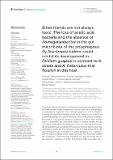Por favor, use este identificador para citar o enlazar a este item:
http://hdl.handle.net/10261/330767COMPARTIR / EXPORTAR:
 SHARE SHARE
 CORE
BASE CORE
BASE
|
|
| Visualizar otros formatos: MARC | Dublin Core | RDF | ORE | MODS | METS | DIDL | DATACITE | |

| Título: | Bitter friends are not always toxic: The loss of acetic acid bacteria and the absence of Komagataeibacter in the gut microbiota of the polyphagous fly Anastrepha ludens could inhibit its development in Psidium guajava in contrast to A. striata and A. fraterculus that flourish in this host |
Autor: | Ochoa-Sánchez, Manuel; Cerqueda‐García, Daniel; Moya, Andrés CSIC ORCID; Ibarra-Laclette, Enrique; Altúzar-Molina, Alma; Desgarennes, Damaris; Aluja, Martín | Palabras clave: | Anastrepha Psidium guajava Acetobacteraceae 16S rRNA Gut dysbiosis Gut microbiota |
Fecha de publicación: | 2022 | Editor: | Frontiers Media | Citación: | Frontiers in Microbiology 13: 979817 (2022) | Resumen: | The gut microbiota is key for the homeostasis of many phytophagous insects, but there are few studies comparing its role on host use by stenophagous or polyphagous frugivores. Guava (Psidium guajava) is a fruit infested in nature by the tephritids Anastrepha striata and A. fraterculus. In contrast, the extremely polyphagous A. ludens infests guava only under artificial conditions, but unlike A. striata and the Mexican A. fraterculus, it infests bitter oranges (Citrus x aurantium). We used these models to analyze whether the gut microbiota could explain the differences in host use observed in these flies. We compared the gut microbiota of the larvae of the three species when they developed in guava and the microbiota of the fruit pulp larvae fed on. We also compared the gut microbiota of A. ludens developing in C. x aurantium with the pulp microbiota of this widely used host. The three flies modified the composition of the host pulp microbiota (i.e., pulp the larvae fed on). We observed a depletion of Acetic Acid Bacteria (AAB) associated with a deleterious phenotype in A. ludens when infesting P. guajava. In contrast, the ability of A. striata and A. fraterculus to infest this fruit is likely associated to a symbiotic interaction with species of the Komagataeibacter genus, which are known to degrade a wide spectrum of tannins and polyphenols. The three flies establish genera specific symbiotic associations with AABs. In the case of A. ludens, the association is with Gluconobacter and Acetobacter, but importantly, it cannot be colonized by Komagataeibacter, a factor likely inhibiting its development in guava. | Versión del editor: | https://doi.org/10.3389/fmicb.2022.979817 | URI: | http://hdl.handle.net/10261/330767 | DOI: | 10.3389/fmicb.2022.979817 | E-ISSN: | 1664-302X |
| Aparece en las colecciones: | (I2SysBio) Artículos |
Ficheros en este ítem:
| Fichero | Descripción | Tamaño | Formato | |
|---|---|---|---|---|
| bitterhost.pdf | 6,32 MB | Adobe PDF |  Visualizar/Abrir |
CORE Recommender
PubMed Central
Citations
4
checked on 05-may-2024
SCOPUSTM
Citations
5
checked on 14-may-2024
WEB OF SCIENCETM
Citations
5
checked on 29-feb-2024
Page view(s)
43
checked on 18-may-2024
Download(s)
19
checked on 18-may-2024

